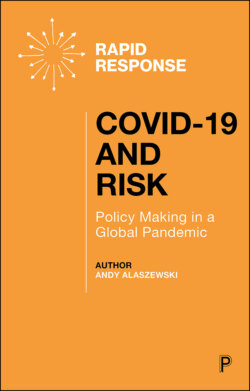COVID-19 and Risk

Реклама. ООО «ЛитРес», ИНН: 7719571260.
Оглавление
Alaszewski Andy. COVID-19 and Risk
COVID-19 and Risk. Policy Making in a Global Pandemic
Contents
List of tables
Notes on the author
Acknowledgements
Preface
1 Introduction
Risk as a way of managing uncertainty
The use of risk to manage uncertainty
Predicting the future
Allocating blame
Other approaches to managing uncertainty. Trust and hope
Limits of rationality: religion, ideology and emotion
Comment
2 The challenge of foresight
The challenge of responding to a new infectious disease
Risk and framing
The development and maintenance of frames
Framing COVID-19
COVID-19 framed as SARS in the western Pacific Rim
COVID-19 and Ebola in West Africa
Framing COVID-19 as seasonal flu
Tensions over the framing of COVID in the US
Effectiveness of the different frames
Case study: the shift from herd immunity to lockdown in the UK in March 2020
Early March: herd immunity
A policy shift in mid-March
Late March: lockdown
Comment
3 The risk of COVID-19
Risk: probability and outcome
Probability, categorisation and outcomes in the COVID-19 pandemic. Identifying ‘at-risk’ groups
Risk categorisation
Pregnant women as higher risk: value without probability. Pregnant women and the precautionary principle
The impact of the high-risk categorisation
The varying experiences of older people during the pandemic
Older people pre-lockdown
Older people during the first lockdown
Older people and allocating vaccines: November 2020
Comment
Case study: deciding on priorities for the COVID-19 vaccine
Approaches and choices: Russia, France and the UK. Russia
France
The UK
What were the options and what was the rationale for vaccination priorities in the UK?
Distributing the vaccine as rapidly as possible
Contributing to social justice
Reducing the rate of transmission
Risk implications
Comment
4 Communicating risk
Risk issue: the challenge of communication
Achieving the right balance
Effective targeting
Communicating the public health message during the pandemic. Developing and communicating a consistent risk message
Mixed messages: public health messaging in the UK and US
Messaging in the UK
Mixed messaging in the US
Case study: Engendering and maintaining trust through effective risk communication in New Zealand. Initial communication of the risk of COVID-19
Using a risk framework to communicate risk
Risk implications
Comment
5 Pandemic narratives
Pandemics and risk narratives. The media and representations of risk
Representing risk through a narrative matrix
Telling the story of the COVID-19 pandemic: numbers and people
Official accounts: numbers and facts
Media narratives: adding moral judgements and emotion to numbers and facts
Telling stories about the failure to manage risk in care homes
Case study: BAME groups and narratives of innocent victims and the guilty parties
Media coverage of the impact of COVID-19 on individuals with a BAME background. Coverage in the US
Coverage in the UK
Risk implications
Comment
6 Contesting risk
Risk issue: the challenges to scientific knowledge. Enlightenment, science and its critics
Distrust of experts and expert knowledge
Distrust of scientific knowledge and conspiracy theories
Populism and conspiracy theories
The COVID-19 paradox: hostile reactions to scientific knowledge. The rapid development of scientific knowledge about COVID-19
Rejection of scientific knowledge
COVID-19 as a product of modern technology
COVID-19 as a hoax
Factors which facilitated the spread of conspiracy theories during the pandemic
Case study: resistance to wearing masks in the US. The science of transmission and prevention
Wearing face masks as a public health measure
Resistance to mask wearing
Risk implications
Comment
7 Hindsight
Risk issue: allocating blame for misfortune
Inquiries, blame and the COVID-19 pandemic. Anticipating the inquiries, deflecting blame
Emerging inquires
The World Health Organization inquiry
Inquiries in the UK
Australia
Comment
Case study: The Ischgl and Paznaun Valley inquiry
Pressure for an inquiry
The setting up and operation of the inquiry
Findings. The timeline of the spread of the virus
What went wrong and whose fault was it?
Risk implications
Comment
8 Conclusion
The challenge of dealing with a novel disease
Unpacking risk: probability and outcomes
Public trust and risk communication
Providing opportunities for pandemic narratives
Leaving space for conspiracy theories
Inquiries and hindsight: the time for reckoning
References
Отрывок из книги
Andy Alaszewski
Notes on the author ix
.....
There was another factor in the willingness to accept COVID-19 as a flu-like disease. It appealed to and served the interests of right-wing populist politicians such as the US President, Donald Trump, the UK Prime Minister, Boris Johnson and the Brazilian President, Jair Bolsonaro. These populist leaders had an interest in representing COVD-19 as flu-like so they could avoid unpopular actions such restricting social and economic activity.
In the US, the flu/herd immunity frame played a central part in the policy debate. At the start of 2020 there was consensus amongst US policy makers that the virus was flu-like and not a high risk. This consensus shifted in March 2020 as the reality of the high level of infection and lethal nature of the disease became evident. In the summer of 2020 as the US Presidential election approached, experts continued to emphasise the dangerousness of COVID-19 but President Trump and his inner advisers returned to their initial framing and minimising of the risks.
.....